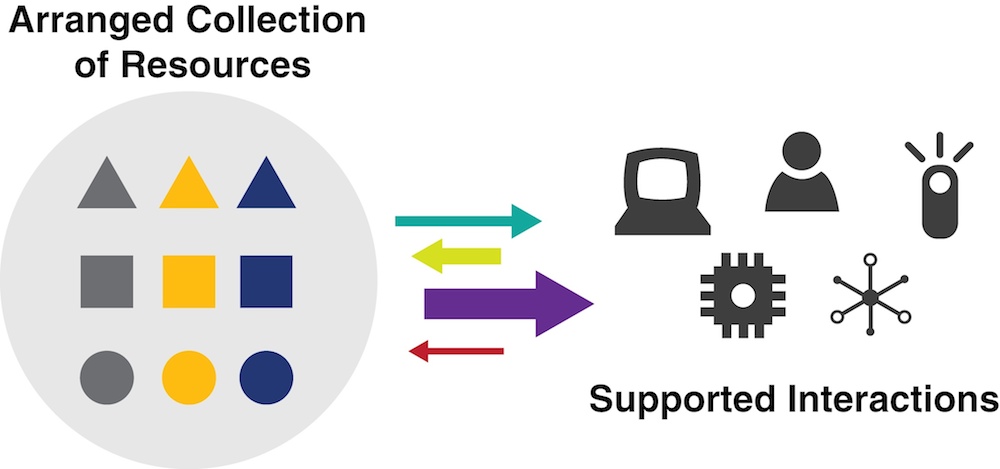2 The “Organizing System” Concept
We propose to unify many perspectives about organizing and information with the concept of an Organizing System, an intentionally arranged collection of resources and the interactions they support. This definition brings together several essential ideas that we will briefly introduce in this chapter and then develop in detail in subsequent chapters.
Figure: An Organizing System. depicts a conceptual model of an Organizing System that shows intentionally arranged resources, interactions (distinguished by different types of arrows), and the human and computational agents interacting with the resources in different contexts.

An Organizing System is a collection of resources arranged in ways that enable people or computational agents to interact with them.
An Organizing System is an abstract characterization of how some collection of resources is described and arranged to enable human or computational agents to interact with the resources. The Organizing System is an architectural and conceptual view that is distinct from the physical arrangement of resources that might embody it, and also distinct from the person, enterprise, or institution that implements and operates it. These distinctions are sometimes hard to maintain in ordinary language; for example, we might describe some set of resource descriptions, organizing principles, and supported interactions as a “library” Organizing System. However, we also need at times to refer to a “library” as the institution in which this Organizing System operates, and of course the idea of a “library” as a physical facility is deeply engrained in language and culture.
Our concept of the Organizing System was in part inspired by the concepts proposed in 2000 for bibliographic domains by Elaine Svenonius, in The Intellectual Foundation of Information Organization. She recognized that the traditional information organization activities of bibliographic description and cataloging were complemented, and partly compensated for, by automated text processing and indexing that were usually treated as part of a separate discipline of information retrieval. Svenonius proposed that decisions about organizing information and decisions about retrieving information were inherently linked by a tradeoff principle and thus needed to be viewed as an interconnected system: “The effectiveness of a system for accessing information is a direct function of the intelligence put into organizing it” (p.ix). We celebrate and build upon her insights by beginning each of the sub-parts of Design Decisions in Organizing Systems with a quote from her book.[1]
A systems view of information organization and information retrieval captures and provides structure for the inherent tradeoffs obscured by the silos of traditional disciplinary and category perspectives: the more effort put into organizing information “on the way in” when it is created or added to a collection, the more effectively it can be retrieved, and the more effort put into retrieving information “on the way out,” the less it needs to be organized first. Sometimes a collection of resources is highly organized, but because it was organized by someone else for different purposes that have in mind, we need to reorganize it “on the way in.” This is especially common with digital text or datasets, where previously organized resources or their descriptions might be sorted, translated in format or language, combined, summarized, or otherwise transformed to fit into a new Organizing System. For example, to understand seasonal buying patterns, a retailer might combine shopping data with weather data and calendar data about commonly-watched sporting events (because bad weather and broadcast sports cause people to stay home), and all three datasets would need to describe “time” and “location” in the same way.
A systems view no longer contrasts information organization as a human activity and information retrieval as a machine activity, or information organization as a topic for library and information science and information retrieval as one for computer science. Instead, we readily see that computers now assist people in organizing and that people contribute much of the information used when computers analyze and organize resources. For example, many algorithms for computational classification use supervised learning approaches that start with items classified by people.
Finally, a systems view can be applied to Organizing Systems with any kind of resource, enabling more nuanced discussion of how economic, social, and cognitive costs and benefits of organizing are allocated among different stakeholders. Every Organizing System is biased by the perspectives and experiences of the people who create it. Some of these biases are inescapable, a kind of automatic organizing, because they reflect innate human perceptual and cognitive capabilities. Our minds impose structure and find patterns, even when there aren’t any, and we are not capable of acting perfectly rationally, so we simplify without realizing it. People are also not very good at thinking about future possibilities and revising their expectations given new evidence, and this mental inertia makes us preserve resources and interactions in Organizing Systems that are no longer needed. Other biases in Organizing Systems reflect more intentional choices that implicitly or explicitly create winners or losers, treat some interactions as preferred while deprecating others, or otherwise impose or overlay a set of values on the stakeholders of the system. For example, many Organizing Systems arrange people in groups or queues to make interactions more efficient, but when an airline gives boarding priority to customers who paid more for their tickets it might not seem fair to you if are in the last boarding group.

